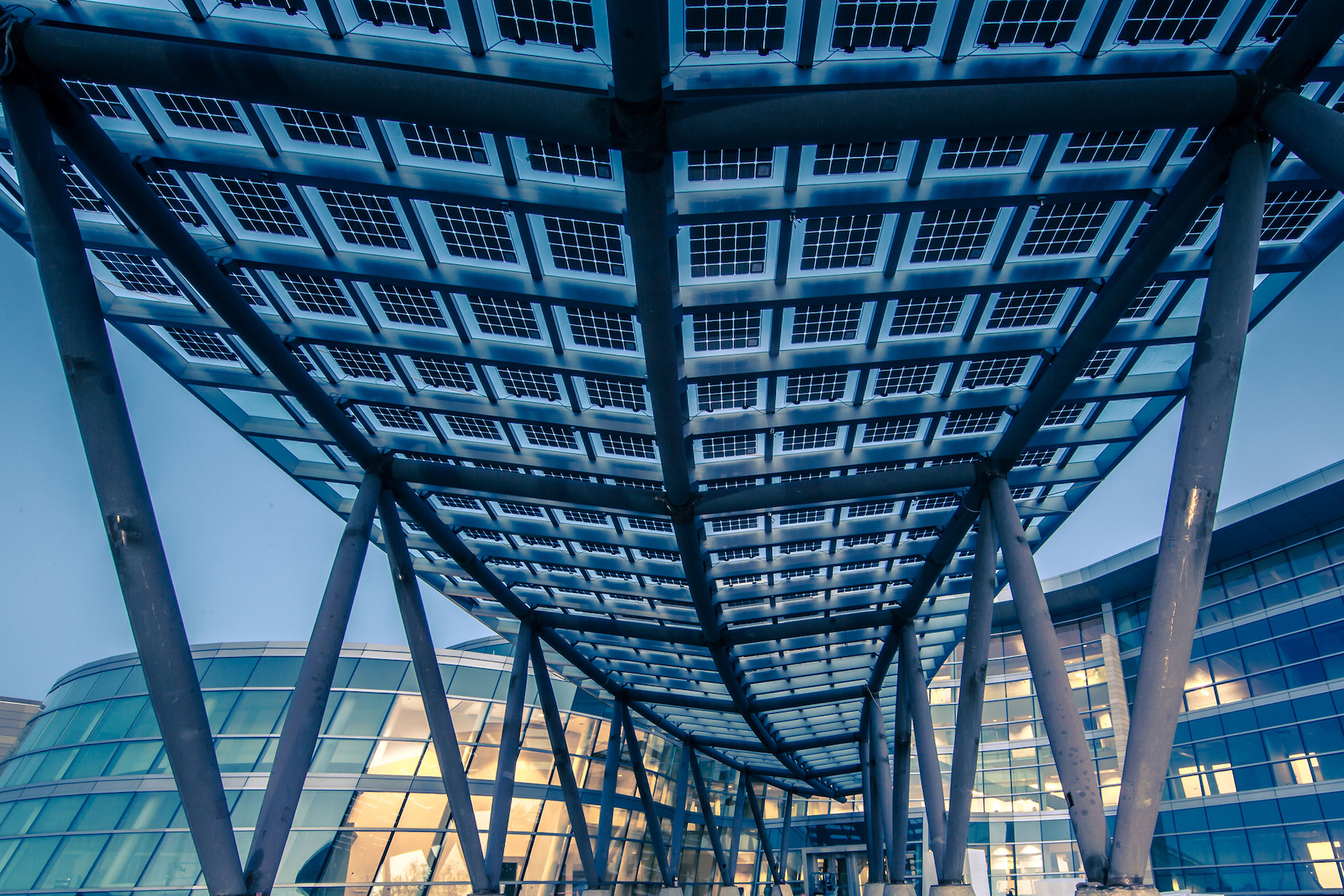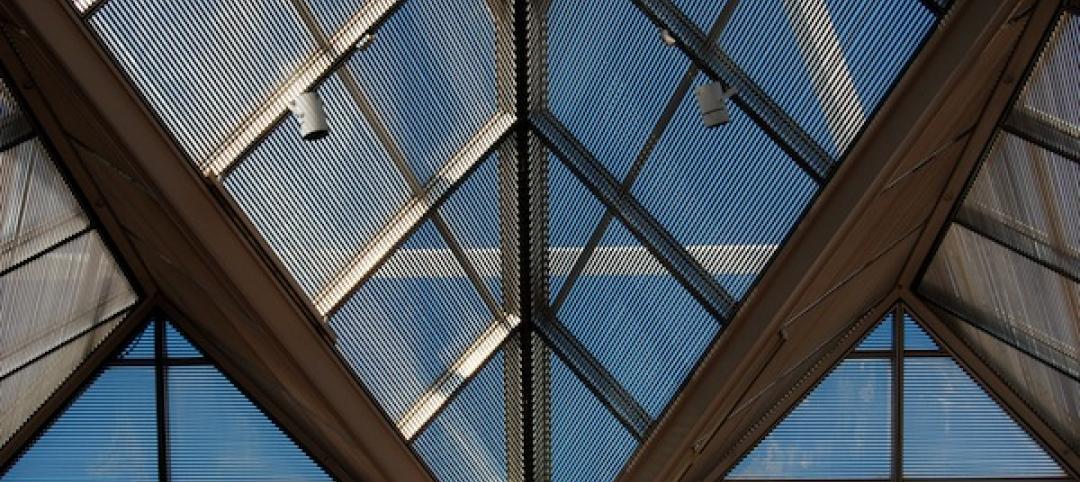Around the world, major government and social initiatives are driving demand for sustainable building design and CO2-free energy. In recent years, as the volume of solar cells being manufactured and installed in buildings has increased, the cost has lowered significantly.
The United States government has supported this effort through the Solar Investment Tax Credit (ITC). Since the program was implemented in 2006, the residential and commercial solar ITC has helped spark 10,000% growth in the U.S. solar industry, with an average annual growth of 50% over the last decade alone. The ITC currently offers a 26% tax credit for solar systems on commercial properties and can be applied to customer-sited commercial solar systems. The ITC credit can apply to aggregate investment in both energy-generating glass panels and electrical components.
Like sustainability, design expectations for commercial buildings are also at an all-time high. In glass specifications, today’s buildings can demand any combination of solar control performance, ultimate transparency, tinted aesthetics and colorful treatments.
Manufacturers like Vitro Architectural Glass have responded with building-integrated photovoltaic (BIPV) glass products like Solarvolt™ BIPV.
Where to Use BIPV Modules
Building-integrated photovoltaic (BIPV) glass modules have emerged as a solution to satisfy these challenges — CO2-free energy generation and design utility — while simultaneously replacing conventional building envelope materials, such as wall cladding or roofing. In fact, BIPV glass can be used to enhance virtually any exterior element: balustrades and balconies, skylights, roof elements, carports and more.

Most notably, BIPV glass modules like Solarvolt™ BIPV can perform the functions of classic glass façades, vision glazing and spandrel glass. In these applications, the solar module replaces conventional building panels and functions as external weather protection for the façade. Tailor-made solar modules comply with all design requirements for glass façades and can be installed with most conventional glass framing systems. For structural glazing, modules utilizing tempered glass with inter-window strips can be integrated into building envelopes and roof surfaces adjacent to heated rooms.
BIPV also can be used for sunshading elements, not only capturing sunlight to generate energy, but also protecting against the sun and glare. BIPV overhead glazing, canopy structures and skylights can harness “solar painting,” a term often used to refer to the interplay of light and shadow resulting from the spacing between individual solar cells. In addition to generating power, BIPV glass balustrades and balconies can highlight the architectural character of buildings and their surroundings while meeting requirements for safety or accident-proof glazing at the same time.
New Design Possibilities
A BIPV module typically consists of solar cells laminated between two glass lites — these can be comprised of virtually any glass product and with any high-performance low-emissivity (low-e) coating to provide yet another measure of environmental performance.
This means BIPV can meet a range of design goals. Designers can realize dynamic, colorful concepts with backpainted BIPV spandrel glass. Blue, green, gray and bronze tinted glasses can also help realize vibrant designs. For ultimate transparency and maximum solar cell performance, low-iron glasses with high visible light transmittance (VLT) also can be used. In fact, Solarvolt™ BIPV modules are compatible with every Vitro Glass product and substrate, including its historic Solarban® family of low-e coatings and Starphire Ultra-Clear® glass.
The BIPV panels’ solar cells themselves can be arranged in rows, alternating patterns and other configurations. Multiple photovoltaic (PV) crystalline silicone technologies also can impact the appearance of the solar cells and their power generation performance. While monocrystalline PV renders a black appearance on solar cells with maximum energy-generation performance, polycrystalline PV delivers a striking blue appearance with slightly reduced performance. For a patterned appearance and higher visible light transmission while retaining some of the energy generation benefits of monocrystalline PV, monocrystalline PV strips are also available.
For decades, glass has been seen as one of the world’s most versatile, beautiful and sustainable building materials. Now, glass is more than just an idea generator — it’s a power generator. Today, glass can collect clean energy, compounding the product’s powerful benefits.
To learn more about Solarvolt™ BIPV glass modules, visit www.vitrosolarvolt.com.
Related Stories
| Mar 20, 2013
Folding glass walls revitalize student center
Single-glazed storefronts in the student center at California’s West Valley College were replaced with aluminum-framed, thermally broken windows from NanaWall in a bronze finish that emulates the look of the original building.
| Mar 14, 2013
PPG appoints Bryan Iams vice president, corporate communications and marketing
PPG Industries announced that Bryan Iams has been named vice president, corporate communications and marketing, effective Oct. 1. Iams will report to J. Rich Alexander, executive vice president.
| Mar 6, 2013
Safti First's two-hour fire rated GPX Framing achieves Level 8 Ballistic Rating
Safti First announced that in addition to meeting ASTM E-119/NFPA 251/UL263 with hose stream for up to 2 hours, the SAFTIfire GPX Framing now has a Level 8 Ballistic Rating per UL 752 Standard for Bullet Resistant Materials.
| Feb 14, 2013
Guardian DiamondGuard installed in the Empire State Building
Guardian Industries DiamondGuard glass was recently installed on the 102nd story of the Empire State Building in New York City as part of an extensive renovation to update this venerable landmark.
| Feb 8, 2013
AAMA and WDMA release updated industry review, trends forecast
Windows and doors report predicts slow growth in commercial construction; analyzes historic data from 2006-11 and forecast data through 2015.
| Jan 28, 2013
Oldcastle Architectural to exhibit at World of Concrete
Oldcastle Architectural, the largest producer of concrete masonry products in North America, will be in full force at the 2013 World of Concrete show February 5-8 in Las Vegas, Nev., featuring new product demonstrations, hands-on competitions and prizes.
| Oct 22, 2012
Two-Hour Curtain Wall Lets Light In and Keeps Fire Out at Prairie Hills Junior High School
New school’s south-facing elevation features a glazed aluminum curtain wall that incorporates PPG Solarblue and PPG Solarban 60 glazing.
| Jul 16, 2012
Business school goes for maximum vision, transparency, and safety with fire rated glass
Architects were able to create a 2-hour exit enclosure/stairwell that provided vision and maximum fire safety using fire rated glazing that seamlessly matched the look of other non-rated glazing systems.
| Jun 29, 2012
Guardian launches industry’s first glass visualizer for interior design
Online tool allows designers to explore the possibilities of glass.















